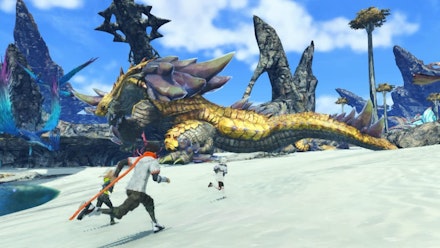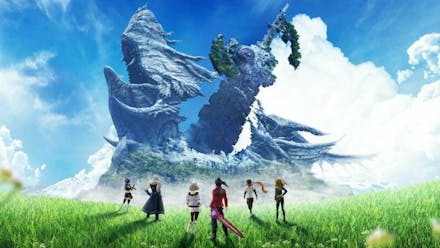Platforms: Nintendo Switch
In the grim darkness of the far future, there is only war. No, you haven’t slipped into a peculiarly anime-styled Warhamer 40,000 game – this really is Xenoblade Chronicles 3, Monolith Soft’s latest entry in its series of sprawling sci-fi action RPGs. It just happens to also be one of the thematically darkest entries to date.
Set on the world Aionios, the nations of Keves and Agnus wage an endless, all-consuming war against each other. Soldiers are vat-grown, spat out in teenaged bodies and living for a maximum of ten years, before being reabsorbed and recycled for the glory of each faction’s respective queen. Battle is such an omnipresent reality that there are no cities or civilisations to fight over, just roaming colonies of combatants locked into endless conflicts where the only prize is the very life force of their enemies, channeled to sustain their own. It is, in a word, bleak.

However, a glimmer of hope emerges when two squads from either side of the eternal conflict are thrown together by a twist of fate, cast as outsiders by both factions and forced to rely on each other to survive. Reluctant necessity grows into a quest to change the entire world, as the unlikely allies – Noah, Eunie, and Lanz from Keves, Mio, Taion, and Sena from Agnus – unlock phenomenal new powers by working together, and begin uncovering long-buried secrets about the war that defined their whole existence.
Most of those discoveries come from exploring Aionios, liberating colonies by destroying the Flame Clocks that lock soldiers into combat servitude. Like any good JRPG, exploring and chatting with survivors of freed colonies also unlocks plenty of side quests, expanding on the core story and introducing a voluminous cast of supporting characters. These are often where shades of optimism and warmth find their way into a narrative that otherwise aches with loss – a side objective throughout the game is finding the abandoned corpses of fallen soldiers and performing last rites for them – and establishing that these people used as disposable tools of war still possess a vital humanity.
Once everything clicks into place, it proves a fantastic experience.
Xenoblade Chronicles 3 doesn’t possess a fully open world, opting instead for several vast locations that can, eventually, be freely travelled between. The minor inconvenience of loading times between areas aside, this offers some of the most beautiful vistas to be found on the Switch, rich in both detail and environmental storytelling. Despite the lack of cities, the wilderness is peppered with ruined artillery, abandoned structures, and remnants from long-gone inhabitants – all hinting that war might not have always been the only thing this world has known.
Like previous entries in the series, Xenoblade Chronicles 3’s battles revolve around an ‘auto-attack’ approach where characters will constantly assault enemies with regular strikes, charging up more powerful abilities that the player can manually unleash. It’s an interesting approach that demands more attention than it may sound, requiring that players focus on attack animations to use charged skills precisely when a basic blow connects for the most damage. The system slowly evolves further over the course of the game, eventually providing satisfyingly complex mechanics and tactical options to sway the tide of each encounter, although unfortunately the key word there is “slowly”.
Players start out with just the Keves trio to control, with each major story beat coming with an attendant expansion of combat options. First it’s the Agnus team joining up, forming one six-member squad to control, before XC3 begins introducing customisable skills, fusion attacks merging two skills into one, and powerful Ouroboros forms where two characters combine into one Evangelion-esque organic robot. Further modifiers – such as recruitable Heroes serving as seventh squad members; additional character classes with their own unique skills; and flashy chain attacks that can inflict millions of damage points on the toughest foes – enhance the overall battle system over the course of the game. Unfortunately, it takes close to 20 hours to get anywhere near this point, with the auto-attack model making earlier sections feel more like the game is playing itself.
Indeed, Xenoblade Chronicles 3’s greatest overall problem is pacing. The depth and consideration of the story means abundant cutscenes, with several of the most important ones having running times close to that of an average anime episode. When following main story quests, there are frequent instances of finishing one cutscene, walking a few steps, then triggering another. In timing a random section of the game’s third chapter, in 65 minutes play, 21 minutes were cutscenes – a frustrating ratio. While all cinematics can be skipped, the story-driven nature of the game means you’ll be left wondering what’s happening if you do. While this is somewhat par for the course for JRPGs, Xenoblade Chronicles 3 is especially egregious in its ponderousness.
Anyone who perseveres through the stultifying early hours of the game will be well rewarded for their commitment though. Once everything clicks into place, Xenoblade Chronicles 3 proves a fantastic experience, with a deeply moving and affecting story and meaty combat that keeps players on their feet. It’s a high point for the series – it’s just a shame that it takes so long to make that clear.
